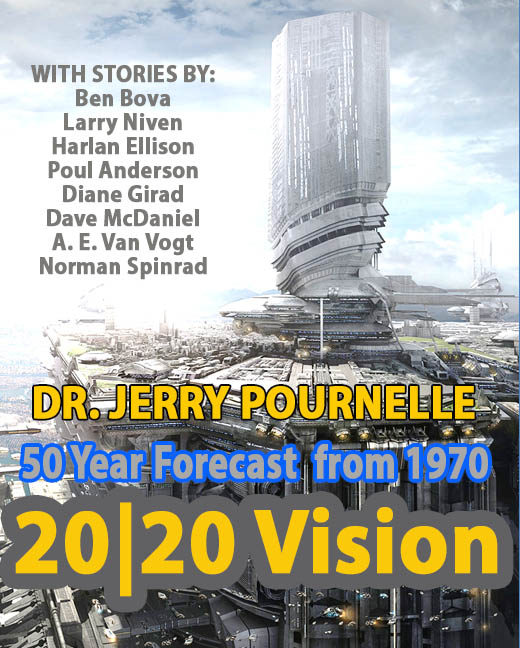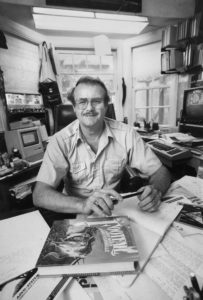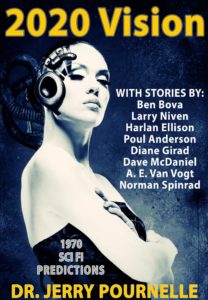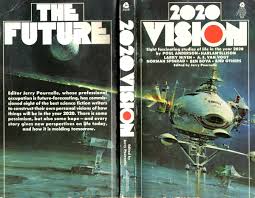YOUR EXTRA REWARD FOR CHAOSMANOR™ SUBSCRIPTION :
20|20 Vision, a 50 Year Forecast from 1970 is available as an eBook FREE with any new ChaosManor subscription or donation.
Buy the updated limited edition 50th Anniversary of 2020 Vision NOW
Here is a sneak peak at the Introduction and the essay Do We Live in a Golden Age. (Please share this page)
The pledge drive continues. If you haven’t subscribed, consider doing it now. It won’t take long. This site operates on the public radio model. It is free, but it can only continue if enough of you subscribed, and renew. If you haven’t subscribed, now would be a good time to do that.
DO WE LIVE IN A GOLDEN AGE?

PREFACE TO 20|20 VISION
By Jerry Pournelle (1971)
Although I write science fiction, I am primarily in the business of predicting the future. Now you may say that’s the same thing, and I will agree, but my predictions don’t usually come out in story form. Instead they are often long and involved arguments, dreary to read unless you’ve paid for them, and use a lot of mathematics. In fact, there is on this earth an organization, of which I am a member, called the World Future Society.
Its membership includes men such as Herman Kahn, Glenn T. Seaborg, Orville Freeman, and other well-known professional prognosticators, and its tools are in large part those of Systems Analysis, Operations Research, Stochastic Modeling, and the like.
The World Future Society is an exciting group and its publications are well worth reading. There is, however, a rival organization in the future-predicting business. Science fiction writers are wont to predict the future every whit as much as the scientists of the World Future Society—and science fiction stories may be more influential than the documented tomes produced by the more orthodox “professionals” in the predicting game.
It is, of course, old hat to list the astounding predictions made by science fictioneers, and the usual blurb tends to emphasize the ones that have duly come true. Atomic bombs, nuclear power plants, space travel and rocket ships; or, going further back in time, submarines, aeroplanes and telephones; all of these were in point of fact “predicted” by some science fiction writer in some story or another. There’s no point in beating this to the ground; many people know our successes.
 On the other hand, science fiction writers have predicted a whole mess of things that just haven’t happened.
On the other hand, science fiction writers have predicted a whole mess of things that just haven’t happened.
I leave out “wild talents,” psionic machines and techniques that harness extrasensory perception for use at will, because the returns aren’t in from the outlying precincts. I also leave out faster-than-light spaceships because although they are now “known” to be impossible, I’m not all that sure—and besides, it’s hard to write a whacking good “space opera” if you’re restricted to the solar system and what’s known at the moment about relativity. (You can do it, though; I think immediately of Poul Anderson’s Tau Zero as an obvious example.)
But even leaving out those favorite SF themes it would be easy to find science fictioneers who predict things that haven’t happened and aren’t going to happen; and somehow when we SF writers get maudlin about our value to the world, we forget all about those.
I can just hear the fans protesting at this point. “Whoa!” they’ll say. “You can’t treat everything written by an SF writer as a serious prediction of the future. Sometimes they were just having fun, or speculating about ‘what-if,’ or trying to make a buck. Besides, the professional prognosticators, you among them, have been just as wrong just as often.”
All of which is so true as to need no further comment.
This book, though, is a book of predictions. It was designed that way. It is not, of course, primarily a test of the power of science fiction writers to predict the future. It is, after all, intended to be entertainment. At the same time, 20/20 Vision gives us a unique opportunity.
We will, many of us writers and readers, be around in 2020, medical science being what it is—-assuming that anyone will be around in 2020. By then, probably, nobody will give a hang what we said here; but the authors of this book hereby serve notice that we will buy a drink at the 2020 World Science Fiction Convention (Marscon?) for each and every reader who brings with him a copy of 20/20 Vision and points out—briefly—just where we went wrong in our visions of the future.
The ground rules on this book were simple. Each author had to write a story which he truly believed could take place in the real world during the year 2020. There were to be no benevolent Alpha Centurian social scientists landing on earth to solve all our problems—unless, of course, the author really thinks the Alpha Centurians are coming in the next fifty years and that they’ll give a damn about saving us when they get here.
Consequently, the Alpha Centurians and all the rest of those grand ideas we entertain ourselves and our readers with are not in this book. The closest they come to creeping in is as allegory in Harlan Ellison’s grim little tale. Instead this is a book of personal visions of the year 2020; some frightening, some edifying, and all, I think, entertaining.
Jerry Pournelle Los Angeles, 1971
INTRODUCTION (CHECK OUT THESE PREDICTIONS!)

DO WE LIVE IN A GOLDEN AGE?
By Jerry Pournelle
When I set out to gather, commission, and bullyrag authors for the stories in this book, I had no idea what the theme would turn out to be.
Surprisingly, as soon as I had collected them, one connecting link fell into place immediately: Do we now, or will we soon, live in a Golden Age?
The Golden Age theme has been popular throughout all recorded literature, but it got a special boost in the writings of the early Greek philosophers. From there it inevitably wormed its way into the literary mainstream of Western Civilization.
It’s interesting to speculate on where the idea of a Golden Age came from. I have recently been doing a lot of research, and I think I know where the Golden Age idea originated, at least among the Greeks and peoples of the Mediterranean. It started with Atlantis, and that all by itself should gladden the heart of every good science fiction reader.
There’s been a lot of literature on Atlantis. At one time when reporters were asked what would be the five biggest stories they ever could imagine, they rated the reemergence of Atlantis at the top, even above the Second Coming of Christ. That was forty years ago. Interest in Atlantis then dwindled, until recently; and now that, as I believe, Atlantis has been found, it wasn’t so big a story after all. Still, it does tell us something about Golden Ages.
According to archeologists1 Atlantis may have been what the people we know as Minoans called their empire. We have no direct evidence of this, but we only adopted the term “Minoan” because we had to call the Cretan Thalassocracy2 something. Using “Minoan” is a bit like saying “Edwardian” for the civilization in England from 900 a.d. to 1315 a.d., a period from the middle of the Anglo-Saxon invasions to Runnymede.
Still, there was a king named Minos, and the name was probably a title like “Pharoah”; and for lack of something better, why not “Minoan”? Only now, I think, we’ve got something better.
Atlantis means the land or people of Atlas, who was mythologically a son of Poseidon—and we know that Poseidon the Earth Shaker, Poseidon the lover of horses and most especially bulls, Poseidon, god of the sea, was held in special veneration by the Cretan Thalassocracy. Besides, the similarity between the Bronze Age civilization Plato described as “Atlantis” reminds us on every line of what we know of Bronze Age Crete.
The Golden Age of Atlantis, then, was a time when the Cretan navy patrolled the seas, rescuing distressed sailors and suppressing piracy; when people lived in cities without walls and apparently could live their lifetimes without participating in war.
It was a time of plenty, with bronze tools, gold jewelry, lovely pottery, free trade on the inland sea, frescoes in private houses, and a code of laws displayed to the people by Talos, the Bronze Man. My own speculation, by the way, is that Talos was the title of the commander of a bronze-armored elite guard who escorted what amounted to a court of assizes on tour throughout the realm of Crete. If you like something better, you’re welcome to think up your own
Somewhere between 1500 B.C. and 1400 B.C., the Cretan Empire was partially destroyed by a sudden calamity. There is plenty of evidence to show that this came at about the same time as the first eruption of Santorin, a still-active volcano some sixty miles from Rnossus, the capital of Crete. While the Cretans were digging out from under the ashes they were conquered by Mycaenean Greeks who might well have been Athenians under a leader named Theseus. There’s no direct evidence for this, but why not?
Then, some thirty to fifty years later, Santorin erupted again, this time with a force estimated at six times that of Krakatoa; and the Empire of the Sons of Atlas was washed over by tsunamis which carried volcanic pumice stone to levels a hundred feet above the sea. The Thalassocracy was ended forever.
According to Plato’s account of Atlantis, the Athenians had already won their war against the Atlantean Empire, and when Atlantis sank into the sea the Athenian army was lost as well….
What this has to do with the present volume is that we can, if Atlantis really was the Golden Age, see just what later men thought was the epitome of civilization. We can dig it up, read its records, look at its everyday life, drink in its accomplishments, and mourn its passing.
And we can wonder if future archeologists will treat us as kindly. According to a number of very serious studies3 we now live in a Golden Age, one that won’t be repeated for a very long time—if ever.4
Just how we’ll lose what we have is a matter for argument.
Conservatives think that “moral degeneracy,” an increasing tendency toward statism, and corruption of the ancient virtues of the American Republic will bring us down to the barbarians of communism (or the left) just as similar factors betrayed Rome first to the Princes, then to the Dominate, and finally to the Goths, Vandals, and Lombards.
Others, not of a conservative persuasion, think we’re headed for a fascist state, repressive for the sake of repression, dedicated to the proposition that anything preserving what we’ve got is all right no matter how brutal we must be to do it.
In fact, about the only thing most commentators of all political persuasions can agree on is that something drastic is going to happen.
Back in the thirties Albert Jay Nock, who believed we were passing into a New Dark Age, was so little noticed that he entitled his masterwork The Memoirs of a Superfluous Man. In those times nearly everyone believed that history was the record of continuous and inevitable progress. Today, Nock’s thesis is taken a bit more seriously.
Dr. Isaac Asimov has a whole list of reasons why we’re all doomed, but they can be summed up in his famous vision of the future: Crowded! This is a view shared by many professional futurologists. A recent issue of The Futurist states flatly: “Man appears to be heading toward a calamitous Day of Reckoning. Unless his rapidly growing population and expanding industrial capacity is somehow brought under control, the earth’s natural resources will be exhausted and the environment so polluted that the world will no longer be livable.”
Nearly every professional study of the future predicts a world population in 2020 greater than twice that at present; some go as high as four times that—fourteen billion people, all crowded onto this “spaceship earth.”
Needless to say, the same studies then show a rapid decline in population—a biological die-off. They also show food per capita increasing slowly until about the year 2000, then falling rapidly as population gets ahead of pest-proof storage bins, miracle rice, fertilizer, sea farms, nuclear powered desalinization of water, and all the other recent technological marvels that together make up the “green revolution.”
Pollution projections start with the present base level shown as almost nil. Pollution rises steadily beginning around 1980 until it, too, peaks, and the die-off begins in the middle of the next century. Meanwhile, the supply of natural resources has been falling since 1900 and will continue to fall at an accelerating rate.
Put it all together onto a curve. Call that curve “Quality of Life,” or “Material Standard of Living.” Whatever you call it, according to some of our best professional projections5 it has already peaked and can go nowhere but down. We live, in this estimate, in a Golden Age which will be remembered fondly and nostalgically if at all.
No matter where we look, then —to politicians of very different ideological persuasion; to futurologists; to ecologists; even to science fiction authors —we see little to hope for. Perhaps, indeed, we live in the Golden Age.
Just how inevitable is the grim future some forecast for us? Can nothing save us?
Well, for one thing, that depends on what we mean by “save”; and perhaps even more it depends on what we mean by “us”. If we mean the people of the United States, salvation may be at hand. Provided that we avoid nuclear war, the U.S. population is presently under control. Best estimates now indicate that it will continue slowly to rise for a while, will peak somewhere around the year 2,000, and then gradually fade back, reaching in 2020 very nearly the present level where it will thereafter remain constant.
Meanwhile, the average age of the U.S. population will creep up and up, leaving proportionately fewer people in the work force, so that if we don’t get cracking with new technology to increase the productivity per worker there’s going to be a good bit less for all of us when we retire. Our present Social Security system is, of course, based on the assumption of continuously rising productivity; it taxes the work force to support those retired from it, and at present levels of taxation and production those who are right now forty years old and under cannot be accommodated when they retire.
Still, there’s no reason to think we can’t increase the productivity per worker; in fact, there are fears in the opposite direction, that automation will so increase output per employed person that we’ll face increasing unemployment of the potentially productive. Which, then, is the greater fear: unemployment or insufficient work force?
Without giving detailed reasons, I think that for the United States, Japan, Western Europe, and the U.S.S.R. technology will be able to keep pace with population trends including the aging of the work force; but when we turn to the rest of the world which will, after all, contain far more than half the people in the year 2020, the picture is much grimmer.
At present rates of energy and natural resource consumption there is not a ghost of a chance that the capital investment needed to bring the “developing nations” into a high-energy/high-technology society—not like ours, but, say, like the one we had in 1940—will be forthcoming. If you take capital investment per person in the U.S. and multiply that by the number of people worldwide in 2020, you come up with a number so big that it isn’t worth reporting. It can’t happen, and that’s that.
(What is the number? Well, present estimates show that it takes about $30,000 capital invested to create one job in the U.S. $3.0 x 105 x 1010 people = $3 x 1015 or three quadrillion dollars; a substantial sum. For 1940 investment levels it’s still up near a quadrillion.)
Moreover, there just isn’t enough iron ore or oil or coal or any other traditional natural resource to allocate enough per capita worldwide to construct a high-technology civilization like ours, or Western Europe’s or Japan’s; it’s going to take quite a lot even to do it for the U.S.S.R.
So where does that leave us? There are several ways to go, and that’s the problem with “scientific” predictions of the future.
Whenever scientists predict, they have to recognize that their own actions will influence the outcome of the game; and even if nobody takes their predictions seriously, still, politicians and other decision makers have a habit of acting quite unpredictably.
But here are some of the ways we could go. First, the Western democracies could voluntarily decrease their standard of living to provide resources—massive amounts of resources—for the rest of the world. Discounting the vast possibilities for mistakes and maladministration of these gifts—and the history of our foreign aid program does not entitle us to discount the possibility at all—there aren’t too many politicians who want to run for office on that platform.
There could be a revolution in the Western democracies which their critics say aren’t very democratic at all to begin with. All well and good, although the objective probability of that is pretty low; but granting that it happened, the record of generosity of revolutionary societies is really rather poor.
 Even assuming that the revolution left the productive mechanism intact so that massive worldwide technological aid and investment was possible, a restructured U.S. society “truly responsive to the will of the people” would probably find the people’s willingness to deprive themselves a bit lower than ideal.
Even assuming that the revolution left the productive mechanism intact so that massive worldwide technological aid and investment was possible, a restructured U.S. society “truly responsive to the will of the people” would probably find the people’s willingness to deprive themselves a bit lower than ideal.
Well, the technologically backward areas of the world might force the high-energy civilizations to divvy up. Since the ways of applying coercive force are directly dependent on the technology available to the contending sides, this doesn’t look very inviting; the chances of India invading the U.S., Britain, or the U.S.S.R. are slim.
China might have greater success at blackmailing the Japanese or the Soviets, but when you really get down to brass tacks their chances will depend on the willingness of those two giants to defend themselves; and after the experiences in Hungary and Czechoslovakia I myself shouldn’t want to bet on the soft-heartedness of the Soviets. Japan alone can’t do that much for China anyway, although she could do a lot.
Where else might we go? Even with new birth control technologies—let’s postulate one thoroughly acceptable to all the churches which now oppose present techniques—the populations of the “developing” nations are going up and up.
Nothing we could do would lower the birth rates worldwide without a considerable time lag; the “green revolution” provides enough food for subsistence survival of an enormous increase in population; and medical technology is easily exportable and in fact is being exported even as I write this.
Increased longevity contributes more to short-run population expansion than birth rate, anyway. The real spurt in Western populations came as a result of the discovery by a Hungarian physician in the last century that if doctors and midwives washed their hands before delivering babies the mothers didn’t die of “puerperal fever” and thus survived to have more children. The doctor was locked up by his fellow physicians as a madman, by the way; they simply wouldn’t believe that they were the cause of the mysterious childbed fevers…
I see, then, only one way out of the dilemma. We’ve got to develop a whole new kind of technology^ one that doesn’t depend on natural resources at all and doesn’t take the kind of capital investment we used to build our own civilization.
Such a technology is possible. The Oak Ridge National Laboratories, for example, have developed a whole program for “instant industrialization” of such barren areas as the Rann of Kutch, the Namib Desert, Sinai, and the Egyptian Red Sea coast.
These make use of fast breeder fission reactors to produce electric power which can be used for desalinization of water. The water supports crops, and the bitterns left from the sea water are “mined” for chemicals and minerals. The waste heat or “thermal pollution” of the reactor is useful energy for the “mining” process; while the breeder construction continuously makes plutonium fuel from now-useless U-238.
There are other possibilities, of course, but they all depend on finding sources of energy other than the traditional fossil fuels. The evidence is overwhelming that a chemical-energy civilization simply cannot be made worldwide, nor sustained if built. We have one energy source—fission—now. Will we find something else, and will we find it quickly?
Given fission technology already on the shelf we could save the Golden Age. The investment requirements are large, but not on the order of quadrillions of dollars; hundreds of billions won’t even be required if the wastage factor is kept to reasonable levels—and provided that “concerned” amateurs don’t bring technology utilization to a screeching halt.
Sure, it would probably be “better” to wait for fusion technology before embarking on worldwide development schemes—but do we have time? It took thirty years to go from Fermi’s pile in the University of Chicago squash court to useful electric power from fission, and there is little reason to believe that fusion or solar screens or any of the other exotic ideas kicked around by science fiction writers and ecologists will do any better. For that matter, not one of those technologies is on the squash court yet. And less than thirty years from now is the year 2000.
That other doom, the population explosion, doesn’t worry me as much as it seems to concern some of our doomsayers. I don’t think, for example, that we shall all go mad because of the number of people per square mile that we can reasonably expect in 2020. The population per unit area of the Netherlands, as an example, is much higher than we’ll ever live to see even throughout Europe; and as anyone who has visited Holland knows, it’s quite a sane and charming place.
Furthermore, the record of industrial society is clear: The higher the technology and the more secure the population, the lower the population growth. That could be because it’s easier to persuade people of the danger. It could even be that only high-energy civilizations look beyond the next few years and give a damn.
I think, then, that the year 2020 could look a lot like the year 1970, only more so and all over, with some of those nice touches that science fiction writers used to add back when we were a more optimistic breed. Antipodes rockets, great wealth per capita, personal computer terminals, pollution-free rapid transportation nearly everywhere at low prices, and all the rest are certainly within our technological capabilities.
Of course, “more of the same” scares some people silly, too, and horrifies others. That’s one area imaginative science fiction writers can help with: It’s easier for an SF author to have a vision of a more pleasant future organization of society than it is for the more traditional scientific prognosticators, who by and large are stuck with trend analysis and projection. On the other hand, we can’t ever forget the rather grim technological realities: Any kind of “pastoral society” based on early twentieth century technology condemns a very large number of human beings to a very unpleasant death.
On the other hand, wealth for the U.S., Europe, Japan, and the U.S.S.R. is within our capabilities no matter what we do about the rest of the world. Unless we act fast that might be the best we can hope for. But whether we can keep that wealth while surrounded by a vast sea of people facing famine and a biological die-off is something else again; and what we may have to do to ourselves to want that kind of life is perhaps even more frightening.
It could be that we’ll be richer in 2020 than we are now—and still see 1970 as The Golden Age.
Notes
- cf. A. E. Galanopoulos and Edward Bacon Atlantis: the Truth Behind the Legend, London: Thomas Nelson and Sons, Ltd. 1969.
- Thalassocracy is rule of the sea, or empire through sea power.
- See particularly the August 1971 issue of The Futurist, Journal of the World Future Society (P.O. Box 19285, Twentieth Street Station, Washington D.C. 20036).
- Harrison Brown, for example, argues convincingly that if we ever lose high-energy technology we can never regain it since we have already stripped the earth of the easily gathered minerals and ores.
- The Futurist, Vol. IV, No. 4, August 1971, p. 138; Jay W. Forrester, World Dynamics, Wright-Allen Press, 1971.
REVIEWS OF 20|20 Vision on AMAZON:
Without any doubt, the top story here is Dian Girad’s “Eat, Drink, and be Merry”. By 2020 we’ve grown so health conscious that dieting and exercise routines are enforced by law, and computers monitor the citizens nonstop for signs of unhealthiness. Against this tyranny, one woman wages a humorous battle and achieves a small victory. (Just please ignore Pournelle’s hilariously sexist introduction.) The other flagship story in this collection is Norman Spinrad’s “A Thing of Beauty”, a melancholy look at a future where Japanese industrial giants dominate the world and loot the national treasures of other cultures, even America.

What a great intro. Somehow I missed this book in high school (graduated in ’71) and Amazon seems to not have any physical copies available, just the typical Kindle edition.
As Jerry pointed out, population growth has slowed, and is not as high on the list of “end of the world” items as the made-up AGW (I try to point out to people that climate change is caused by the sun, and our use of internal combustion engines won’t affect that one whit), and a plastic straw laden island in the Pacific is now the visible manifestation of making disposable things that do not readily break down.
Jerry wrote at length in the run up to the less than optimal outcome of Persian Gulf War 1 (1990) that we should build reactors all over the country, all clones of a test model we’d get from the French reactors that still seem to run well. He advised $100 billion for the project plus cost overruns – of course – and as he advised, “tell the Arabs they can drink their oil.” Why does no one ever listen to the smart guy in the room? Twenty years and $6 trillion or so later, now we have fracking. Not exactly an upgrade.
Any hope of a reissue as a physical book?
– James Ponder
The 50th Anniversary Edition of 2020 Vision shall be available in print late this month on Amazon. And a good thing…used copies of the original paperback are going for $50 to $313.
I think the smart money today would be on thorium.
How Can I Copyright Protect Stories and Articles on My Website?
I still have my paperback copy of 2020 Vision. I had planned to re-read it this year, but haven’t gotten around to it. Over the holidays, perhaps.